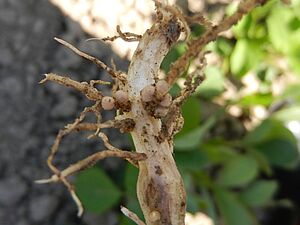In organic agriculture, legumes carry an important function within the crop rotation. They can bind atmospheric nitrogen in the soil via a symbiotic relationship formed with soil bacteria. Through this process of biological nitrogen fixation, they make nitrogen available not only to themselves but also for succeeding crops. Cultivating legumes also positively affects soil fertility due to the intense rooting system and the ability of legumes to breakdown phosphorus compounds. Apart from grains legumes, other legumes play an important role in organic farming, for instance, as green manure or high protein forage crops (e.g. grass-clover).
Organic cultivation of grain legumes
In Europe, there is a great demand for protein-containing raw materials; especially for fodder, which is mostly imported. However, domestic grain legumes are also increasingly being used for human nutrition: the demand for pulses and new, innovative products made from them is growing steadily.
There is a push to grow more protein-rich crops domestically to become less dependent on imports. However, the domestic production of grain legumes under organic conditions has its problems; weed control is demanding, and especially late weed infestation becomes a challenge, plants are sensitive to soil compaction, and some varieties are not stable causing a loss in quality. If too many legumes are cultivated within the crop rotation, meaning the breaks are too short, so-called legume fatigue in soils can occur, which makes cultivation uneconomical or even impossible. Moreover, soya imports are much cheaper than soya from domestic production, which means that the yield and quality of local cultivation need to be improved.
Increasing drought and heat and the associated new diseases and pests pose significant challenges for cultivation. Therefore, the breeding of varieties suitable for our climate and the development of cultivation techniques adapted to local conditions play a major role.
However, with informed background knowledge and a suitable cultivation technique, the cultivation can be economically viable. On the one hand, because the trend toward regional and GMO-free feeding of milk- and meat-producing animals is becoming ever stronger. On the other hand, because legume cultivation contributes more than is initially evident from the respective yield. The cultivation of native protein crops can increase biodiversity as well as genetic diversity in the agricultural landscape and at the same time it contributes to essential ecosystem services, since they do not require, for example, energy-intensive nitrogen fertiliser to thrive.
FiBL has been working for many years with breeders, seed producers, organic farmers, feed mills, processors and other research institutions in the areas of cultivation and processing in national and international projects on grain legumes. The aim is to ensure that soybeans and native grain legumes, such as peas, field beans and sweet lupins, are firmly established in the local organic agriculture and food industry and that they are used for animal and human nutrition as an alternative to imported protein sources or as raw materials for innovative products.
Since 2019, FiBL has been offering courses where participants can learn all about processing soybeans into tofu and other products.




